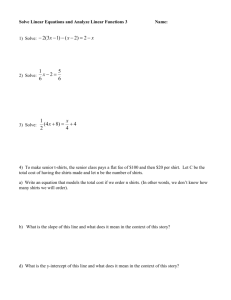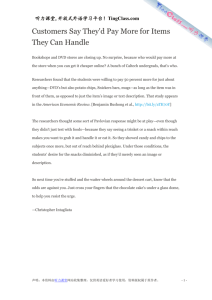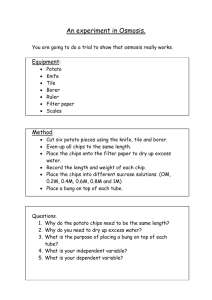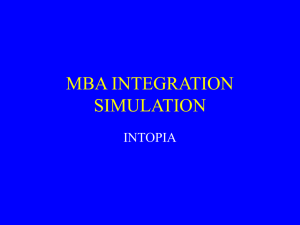Capital Abundant
advertisement
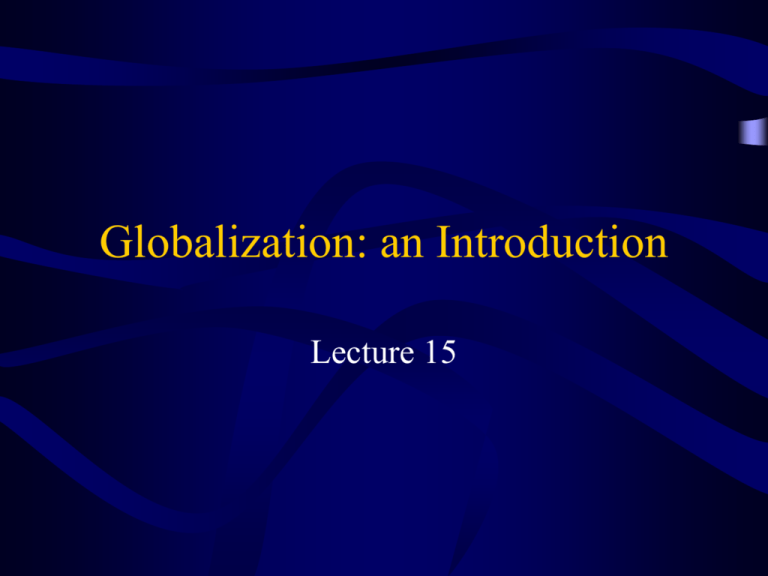
Globalization: an Introduction Lecture 15 Some Simple Facts About the Global Economy In 2000: • World Trade Totaled $7.6 Trillion. • About 63,000 Multi-National Corporations (MNCs) Operate in the Global Economy – Controlling About 690,000 Foreign Affiliates – Employing About 86 Million People. • Foreign Direct Investment Totaled $1.3 Trillion. • About 30 Countries in Western Europe, North America, and Asia Account for About 75% of this International Economic Activity. Causes and Consequences • The Political and Economic Structure of the Global Economy – What Does the Global Economy Look Like? – How Did We Get Here? • The Consequences of Economic Globalization – Who Wins, Who Loses? • Within the United States; Advanced Industrial Economies More Broadly: MNCs vs. Labor? • Within the World Economy: Capitalist Countries vs. Developing Countries? International Trade Growth of World Trade 600 500 400 300 200 Industrial Revolution 100 0 18 50 18 96 19 13 19 24 19 30 19 35 19 48 19 53 19 63 19 68 19 71 Volume GATT-Based System World Trade, 1968-1997 6000 $US Billions 5000 4000 3000 2000 1000 0 1968 1973 1978 1983 1988 1993 19 51 19 54 19 57 19 60 19 63 19 66 19 69 19 72 19 75 19 78 19 81 19 84 19 87 19 90 19 93 19 96 19 99 Percent Change Growth of World Output and Trade 15.0 10.0 5.0 0.0 -5.0 -10.0 GDP Growth Trade Growth Distribution of World Trade EU 21.2% 6.0% 6.3% 17% Asia/Pacific North America 9.6% 10.7% 5.3% 6.2% Rest of the World 4.4% 12.8% 60% of All Trade Among the Advanced Industrialized Countries The Multilateral Trade System: GATT and the WTO • GATT: General Agreement on Tariffs and Trade: Created in 1947. – An Agreement (legal text specifying rules) – An Organization (a body that facilitated trade negotiations). • WTO: World Trade Organization: Established in 1994 – An International Organization Charged with: • Monitoring Compliance with rules (including GATT) • Resolving Trade Disputes • Facilitating Trade Negotiations Why Trade? Comparative Advantage • Simple Concept, Widely Misunderstood. • U.S. Can Make Two Products: – Computer Chips – Clothing (Apparel) • Assume U.S. Has an Absolute Advantage in Both. • The U.S. Should Produce and Export Chips and Clothes, Right? • David Ricardo asked, How Many Chips Do We Give Up? • Produce Clothes at Home, – Give up 10 Chips for Every 1,000 Shirts. – Thus, 1 Chip “Buys” 100 Shirts. • Buy Clothes from Foreign Country – We Give up 5 Chips for Every 1,000 Shirts. – Thus, 1 Chip “Buys” 200 Foreign Shirts. • We are Better Off—Can Consume More Chips and Shirts—if We Produce Only Chips and Exchange these Chips For Shirts Produced in Other Countries. • Thus, Even though the US Has an Absolute Advantage in Both Goods, it Has A Comparative Advantage in Semiconductor Chips. • The U.S. Gains By Specializing in Chips and Importing Shirts. Factor Endowments: The Basis of Comparative Advantage • Factors of Production: Capital and Labor • Factors Held in Different Amounts in Different Countries. – Capital Abundant: Lots of Capital and Little Labor – Labor Abundant: Lots of Labor and Little Capital • Production of Different Goods Uses Factors in Different Amounts. • Capital-intensive Goods – Production Relies relatively more on Capital than Labor (Autos) – Comparative Advantage in capital abundant countries. • Labor-intensive Goods – Production Relies Relatively more on Labor (Apparel) – Comparative Advantage in labor abundant Countries. • Capital-intensive goods traded for labor- intensive goods. Factor Endowments and the International Economy • Capital-Abundant Industrialized “Core” countries—the U.S., Western Europe, Japan, the NICs (Newly Industrializing Countries). • Labor-Abundant “Periphery” Countries—Latin America, Africa, parts of Asia. • Global Division of Labor in the International Economy between North and South Four Central Points • Historically Unprecedented Growth of World Trade in Postwar Period. • Trade dominated by Industrialized World, and developing countries play much less important role. • Trade Based on Comparative Advantage is Mutually Beneficial • Result Has Been Deepening of Economic Integration Among the Advanced Industrialized Countries--Globalization Questions: • • • • • How Did We Get Here? What are the Implications of Being Here? Who Wins and Who Loses? Is Globalization “Good” or “Bad?” What Role does the World Trade Organization Play in the System? • What About Developing Countries?
